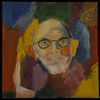Sensor Size Numbering???
Jul 10, 2017 07:37:40 #
And let us not forget that the number of pixels that the sensor maker packs onto a sensor is also a factor. My D70s and my D300s had the same size sensor, but the older model had 6MP while the newer one had 12MP. And in addition to a D810 I also have an E-M1 4/3 body. It has a smaller sensor that the D300s, but 16MP, more advanced processor technology and no AA filter. Even though the sensor is smaller than APS-C, it outperforms a D300s. Just sayin'
Jul 10, 2017 07:56:45 #
SOLINA DAVE wrote:
I understand now that the sizing of a digital sens... (show quote)
I think the 1" sensor size was/is just a con job on the part of the camera makers. They got caught, and although many still call it a 1" sensor, Sony now refers to it as a 1" Type sensor.
If all things were equal (they are not) more pixels means more detail while larger sensors equate to better low light performance and less noise.
No one spec makes or breaks a camera. The race to have the most pixels, to a large degree, is like the horsepower race between the auto manufacturers back in the '70s. Many cars had twice the power there was a need for, but is sounded good in the advertisements.
Before making a purchase read the published reviews from the major photography sites. Then ask real life, everyday users, what they think about it. The best way to get an idea if the reviewer knows what they are talking about, after reading the words look at the photos they post. No photos "might" mean they talk the talk but don't walk the walk.
Good luck!
--
Jul 10, 2017 10:49:54 #
Sensor size affects field of view as compared to 35mm...Not quality or better as you ask. Search UHH and there are lots of articles on this....Or search the web....But I would search here first. Lots of smart people here.....It all depends what you want to do.......If you can afford a full size sensor, then get it and you won't have to worry about different sizes.
Jul 10, 2017 11:42:02 #
That 1/(number to one decimal in inches) is a hold over from the "optical format" of early television days. It is related to the sensor diagonal dimension.
Jul 10, 2017 12:21:55 #
A strange relationship - the diagonal dimension of a rectangle 12.8 mm x 9.6 mm is 16 mm, or 0.63 inches. I think a con job is a better answer!
Jul 10, 2017 13:08:50 #
SS319 wrote:
A larger sensor in terms of the number of pixels y... (show quote)
This is an excellent answer. The designation (4/3, aps-c, etc) come mostly from marketing people. Not entirely, of course, but mostly. They pulled off two scams as an industry. They made a tiny sensor and called it 1-inch. They justified that by comparing it to the old 1 inch vidicons we used in early TV broadcasting. (The one-inch vidicon had an OUTSIDE diameter of 1 inch.) In other words, as the cavalry Colonel used to say "horse-puckies."
The second scam was to call the 35mm sensor, "Full Frame." Full-frame compared to what? A Pentax 4x5? A Hassie digital back? Part of this was calling the aps-c a "crop sensor". The aps-c is full-frame. It doesn't throw away half the image. The 35mm sensor doesn't magically create a bigger print. (Not saying that the FF doesn't have some advantages under certain specific situations. But the aps-c has advantages too under other circumstances. The so-called 1 inch sensor has no advantages at any time.)
Jul 10, 2017 13:17:13 #
therwol
Loc: USA
Reinaldokool wrote:
The so-called 1 inch sensor has no advantages at any time.)
It does if you want a camera you can fit in a pocket. I own a Nikon D810, but it isn't suitable to carry it everywhere I go. I'm sorry to say that. It takes beautiful pictures. It's just too large, bulky and conspicuous (where there is a risk of theft) for some casual sightseeing with family members. I looked at alternatives very carefully. The pocket requirement (mine) ruled out many fine cameras with larger sensors, either because of interchangeable lenses sticking out or viewfinders sticking up. I bought a Canon G7X Mark II. I have no complaints.
Jul 10, 2017 13:54:39 #
therwol wrote:
It does if you want a camera you can fit in a pock... (show quote)
I bought a little Panasonic for the same reason. Even just running up to the store I throw it in the console, just in case.
--
Jul 10, 2017 14:38:35 #
therwol wrote:
Sensor size also equates to camera size. If you w... (show quote)
If you can get a 1" sensor camera in your pocket.... you have been taking your shirts and/or jeans to "Omar the Tentmaker" and having the pockets enlarged, methinks!
Jul 10, 2017 15:00:31 #
therwol
Loc: USA
Kuzano wrote:
If you can get a 1" sensor camera in your pocket.... you have been taking your shirts and/or jeans to "Omar the Tentmaker" and having the pockets enlarged, methinks!
My Canon G7X Mark II fits comfortably in regular pants pockets. I'm 65, and my days of wearing tight jeans are over. The G9X should fit in a shirt pocket. I didn't buy that because of the more limited zoom range. Both of these cameras have 1 inch sensors, retractable lenses, and no separate viewfinder. That's how they can fit in a pocket.
https://www.amazon.com/Canon-PowerShot-G7-Mark-Black/dp/B01BV14OXA
https://www.amazon.com/Canon-PowerShot-Digital-Camera-Bluetooth/dp/B01N9MCH0E/ref=dp_ob_title_ce
G9X is also available in black.
Jul 10, 2017 15:27:30 #
SOLINA DAVE wrote:
This will no doubt be a very elementary subject fo... (show quote)
The system for characterizing sensor sizes was developed by the IRS and then translated into Japanese by an Eskimo. It was them simplified and translated back into English by a consortium of Canon, Nikon and Youngno engineers and the entire system is administered by Comcast customer service.
Jul 10, 2017 15:40:40 #
fantom wrote:
The system for characterizing sensor sizes was developed by the IRS and then translated into Japanese by an Eskimo. It was them simplified and translated back into English by a consortium of Canon, Nikon and Youngno engineers and the entire system is administered by Comcast customer service.
I'm sure it is the administrator that screwed it up!
--
Jul 10, 2017 17:44:51 #
BJW wrote:
Without getting scientific, here's how I understan... (show quote)
Very good!! An excellent analogy indeed. And you have cast a great deal of light on the subject. At least for me, you certainly have.
Thank you..............Dave

Jul 10, 2017 19:47:48 #
SOLINA DAVE wrote:
This will no doubt be a very elementary subject fo... (show quote)
All of the sensor sizes have a story explaining how they were named. Not worth knowing unless you have a photographic memory or will be taking a quiz. Obvious thing is to find a visual chart you like and put it on your computer desktop, cell phone, or make a print - whatever is easy to find.
As others have said, chose a category of cameras based on what you want it to do. I love DPReview for easy comparisons, including lists of cameras designed for similar purposes. (I include the high priced ones just to see what I am giving up because of cost.) I have no personal acquaintances that bought a camera to get the biggest sensor and/or highest pixel count within their budget. That should be relative to how big you want to project the image, and is just part of what makes a "sharp" picture. The quality and quickness of the focusing system has always been my number one consideration - because I am a candid snap shooter! Weight is my new concern since passing 70.
Boris
Jul 10, 2017 20:16:17 #
BebuLamar wrote:
The inch size is the dimension of the outer diameter of video tube so the actual diagonal dimension of say a 1" sensor is less than 1". The same goes for all the sensor size based on inch. These sizes used back in the days when video cameras used tube as imaging sensor.
Much less...half. It is perhaps the most misleading designator.
I am surprised there hasn't been a class action lawsuit on it as there was with tv screen sizes.
If you want to reply, then register here. Registration is free and your account is created instantly, so you can post right away.









